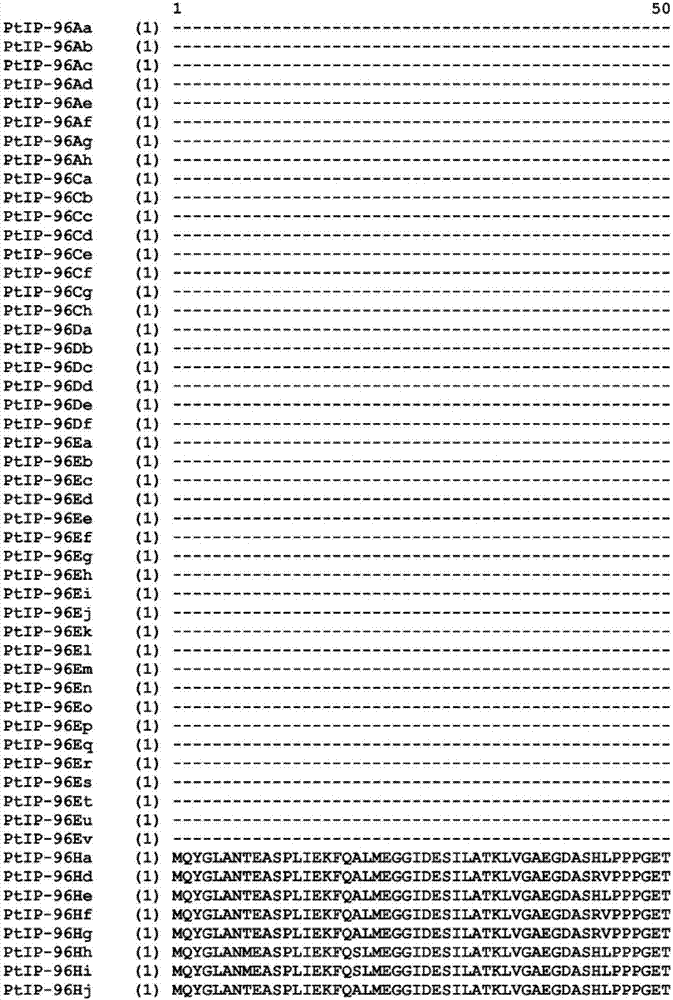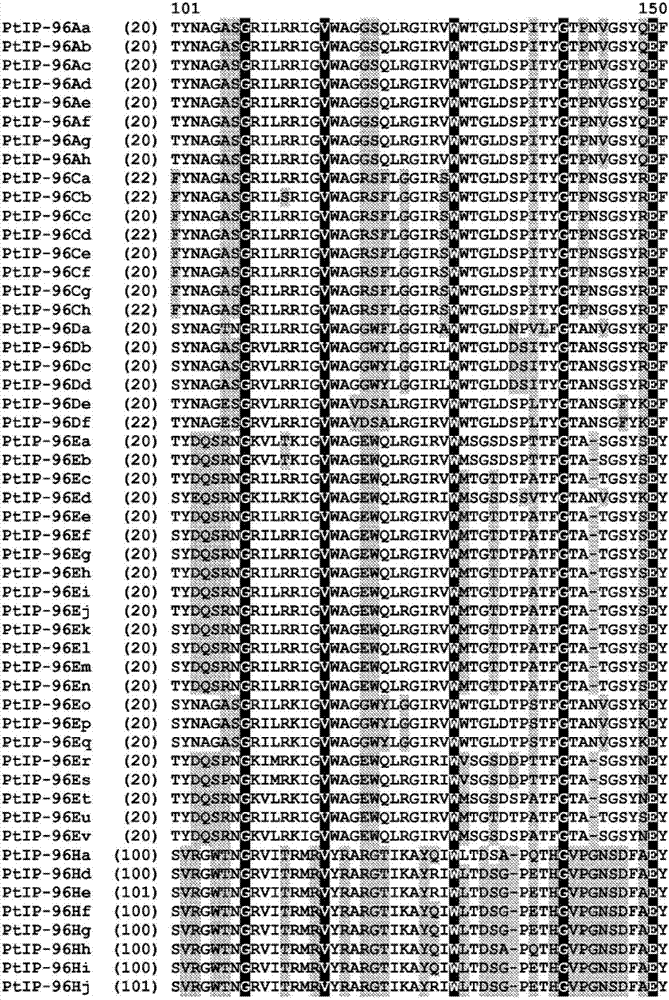Insecticidal proteins and methods for their use
A technology for insects and pests, applied in the field of molecular biology
- Summary
- Abstract
- Description
- Claims
- Application Information
AI Technical Summary
Problems solved by technology
Method used
Image
Examples
Embodiment 1
[0401] Example 1 - Identification of insecticidal protein activity from Selaginella kraussiana
[0402] BLAST (Basic Local Alignment Search Tool; Altschul et al., (1993) J. Mol. Biol. 215:403-410; see also ncbi.nlm.nih.gov / BLAST / , which can be accessed using the www prefix) identified the amino acid sequence of SEQ ID NO:9. Primers were designed using the transcriptome sequence to clone the PtIP-96Aa cDNA sequence. This clone uses KOD Hot Start DNA A PCR kit (Novagen, Merck KGaA, Darmstadt, Germany) was generated by polymerase chain reaction using total RNA from Paleopsis praecox (sample Id. PS-8780) as a template. Cloned PCR products were confirmed by sequencing. Based on DNA sequencing, the PtIP-96Aa polynucleotide sequence is shown as SEQ ID NO:4 and the encoded polypeptide sequence is shown as SEQ ID NO:9.
[0403] In a 96-well plate format, the three pests were tested using plant tissue protein extracts obtained from Lepidoptera pachyrhiza sample PS-8780 overlaid o...
Embodiment 2
[0406] Example 2 - Transcriptome sequencing of Cuiyuncao
[0407] The Transcriptome of C. paliscens from sample Id. PS-8780 was prepared as follows. used for total RNA isolation Kit for the isolation of total RNA from frozen tissues. used from Inc.'s TruSeq TM The mRNA-Seq Kit and Protocol (San Diego, CA) prepared sequencing libraries from the resulting total RNA. Briefly, mRNA was isolated by ligation to oligo(dT) magnetic beads, fragmented to an average size of 180nt, reverse-transcribed into cDNA by random hexamer primers, end-repaired, A-tailed to 3', and bound to Have Indexed TruSeq TM Joint connection. use TruSeq TM The ligated cDNA fragments were amplified by PCR with primers, and the Agilent The quality and quantity of purified PCR products were checked on a DNA7500 chip. After quality and quantity evaluation, by using double-strand specific nuclease (Duplex Specific Nuclease, DSN) ( Moscow, Russia) treatment normalized 100 ng of the transcript libr...
Embodiment 3
[0409] Identification of embodiment 3-PtIP-96 polypeptide homologues
[0410] Homologs of the PtIP-96Aa polypeptide (SEQ ID NO: 4) were identified using BLAST gene identities expressed in the internal DUPONT PIONEER transcriptome database of ferns and other native plants. Table 2 shows the PtIP-96Aa polypeptide homologues and organisms identified therefrom. In some cases, congeners were identified from pooled samples of fern isolates and / or species indicated in Table 2 as "Mix 1", "Mix 3" and "Mix 4". The ferns in the pooled samples are shown in Table 3.
[0411] Table 2
[0412]
[0413]
[0414] table 3
[0415]
[0416]
[0417] cDNA is generated from the original organism with identified homologues by reverse transcription from total RNA or synthesized based on sequences assembled from transcriptomes. The cDNA-derived genes encoding PtIP-96 homologues were PCR amplified from their corresponding cDNAs using primers designed to encode the sequences of t...
PUM
 Login to View More
Login to View More Abstract
Description
Claims
Application Information
 Login to View More
Login to View More - R&D
- Intellectual Property
- Life Sciences
- Materials
- Tech Scout
- Unparalleled Data Quality
- Higher Quality Content
- 60% Fewer Hallucinations
Browse by: Latest US Patents, China's latest patents, Technical Efficacy Thesaurus, Application Domain, Technology Topic, Popular Technical Reports.
© 2025 PatSnap. All rights reserved.Legal|Privacy policy|Modern Slavery Act Transparency Statement|Sitemap|About US| Contact US: help@patsnap.com



